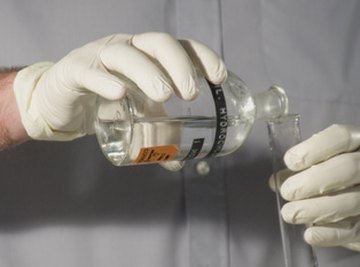
When an ionic molecule, like table salt, dissolves in water, it separates into anions and cations. Anions are atoms or molecules that are negatively charged because they have one of more extra electrons. Cations are atoms or molecules that are positively charged because they are missing one or several electrons. Calculating the concentration of an ion that results when an ionic molecule dissolves in water is not a difficult thing to do as long as you know the molecule's solubility constant and the concentration of the oppositely charged ion.
Consider the ionic molecule you are studying and determine how it dissolves in water--what are the resulting cations and anions. For example, lead(II) fluoride, PbFl2, yields lead cations and fluorine anions. Generally, the molecular formulas of ionic molecules are written with the cation first.
Look up the solubility product constant of your molecule. The solubility product constant is a reflection of how thoroughly the ionic molecule dissolves in a 1 Molar (M) solution. The second link in the References section below contains the solubility constants for many ionic molecules. From there, we see that the solubility constant for lead(II) fluoride is 1.1 x 10^-7.
Write the general equation for the solubility product constant, then fill in the details for the molecule you are studying. The solubility product constant for a generic ionic molecule AyBz is:
Solubility Constant = (Concentration of A)^y x (Concentration of B)^z
If we add one mole of PbFl2 to enough water to give us a total PbFl2 concentration of 1 Molar (M), our equation will look like this:
1.1 x 10^-7 = (Concentration of Pb cation)^1 x (Concentration of Fl anion)^2))
Learn the concentration of either the cation or the anion to solve for the other. You cannot calculate the concentration of one ion without knowing the other. Problems in chemistry books will always give one; in the laboratory you would have to measure the concentration of one of the ions using titration. In our example, imagine that the concentration of the fluorine anion in solution was 3.0 x 10^-3 M.
Solving the solubility constant equation for the concentration of Pb cation gives us:
Concentration of Pb cation = 1.1 x 10^-7 / Concentration of Fl anion
Plugging in the known concentration of the Fl anion yields.
Concentration of Pb cation = 1.1 x 10^-7 / 1.0 x 10-3 = 1.1 x 10 ^-10 M
The concentration of lead cation in a PbFl2 solution with a fluoride anion concentration of 1.0 x 10^-3 M is 1.1 x 10^-10 M.
References
About the Author
Timothy Banas has a master's degree in biophysics and was a high school science teacher in Chicago for seven years. He has since been working as a trading systems analyst, standardized test item developer, and freelance writer. As a freelancer, he has written articles on everything from personal finances to computer technology.
Photo Credits
chemistry image by david hughes from Fotolia.com
